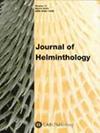啮齿动物是西非塞内加尔理查德-托尔地区曼氏血吸虫传播的蓄积宿主
IF 1.3
3区 生物学
Q4 PARASITOLOGY
引用次数: 0
摘要
对塞内加尔理查德-托尔地区的六种不同啮齿动物和一种食虫动物的 2000 多只动物进行了血吸虫感染检查。发现两种鼠科啮齿动物(Arvicanthisniloticus和Mastomyshuberti)感染了血吸虫。这两种啮齿类动物的感染率约为 5%,平均每只宿主携带约 20 个蠕虫。曼氏血吸虫的性别比例总是偏向雄性。虽然雌雄啮齿类动物的感染率和虫体负荷相似,但随着年龄的增长,感染率和虫体负荷显著增加。啮齿动物栖息地附近的感染率和蠕虫量最高,随着与理查德-托尔镇距离的增加,感染率和蠕虫量明显下降。在两种自然感染的啮齿动物的肝脏和粪便中也发现了虫卵。结果表明,啮齿类动物参与了理查德-托尔镇的肠血吸虫病传播,但人类才是主要的感染源。曼氏血吸虫人鼠分离株之间的遗传相似性表明,需要在塞内加尔的这一地区开展进一步的流行病学研究。本文章由计算机程序翻译,如有差异,请以英文原文为准。
Rodents as reservoir hosts in the transmission of Schistosoma mansoni in Richard-Toll, Senegal, West Africa
More than 2000 animals belonging to six different rodent species and one insectivore species were examined for infection with schistosomes in the region of Richard-Toll, Senegal. Two murid rodents, Arvicanthis niloticus and Mastomys huberti , were found infected with Schistosoma mansoni . Prevalences were about 5% for both rodent species with a mean worm burden of about 20 worms per host. The sex-ratios of S. mansoni worms were always biased towards males. Prevalences and worm burdens, although similar in both male and female rodents, increased significantly with age. The highest prevalences and worm burdens were found near habitations and decreased significantly with the distance from the town of Richard-Toll. Eggs were also observed in the liver and faeces of the two naturally infected rodent species. The results suggest that rodents participate in the transmission of intestinal schistosomiasis in Richard-Toll but the human population is the main source of infection. The genetic resemblance between human and murine isolates of S. mansoni suggests that further epidemiological studies are needed in this region of Senegal.
求助全文
通过发布文献求助,成功后即可免费获取论文全文。
去求助
来源期刊

Journal of Helminthology
生物-动物学
CiteScore
2.80
自引率
12.50%
发文量
127
审稿时长
3 months
期刊介绍:
Journal of Helminthology publishes original papers and review articles on all aspects of pure and applied helminthology, particularly those helminth parasites of environmental health, medical or veterinary importance. Research papers on helminths in wildlife hosts, including plant and insect parasites, are also published along with taxonomic papers contributing to the systematics of a group. The journal will be of interest to academics and researchers involved in the fields of human and veterinary parasitology, public health, microbiology, ecology and biochemistry.
 求助内容:
求助内容: 应助结果提醒方式:
应助结果提醒方式:


